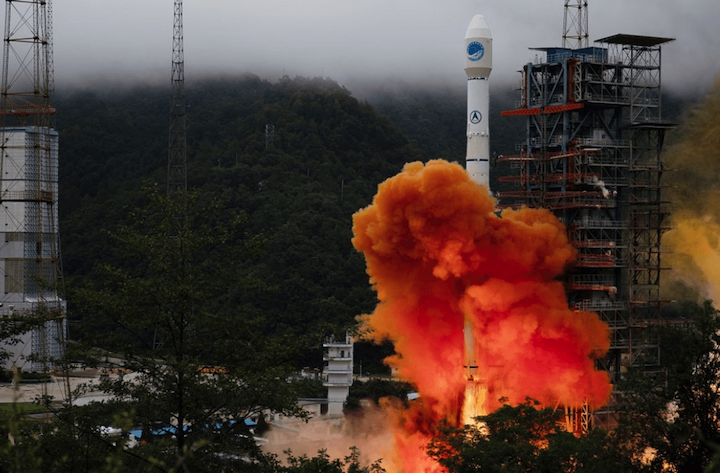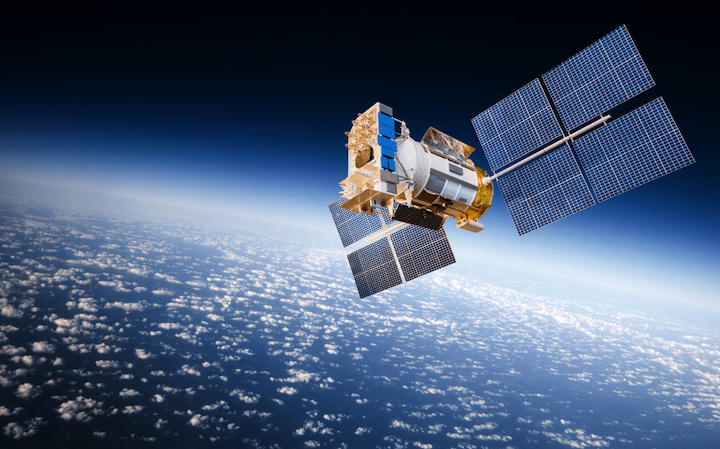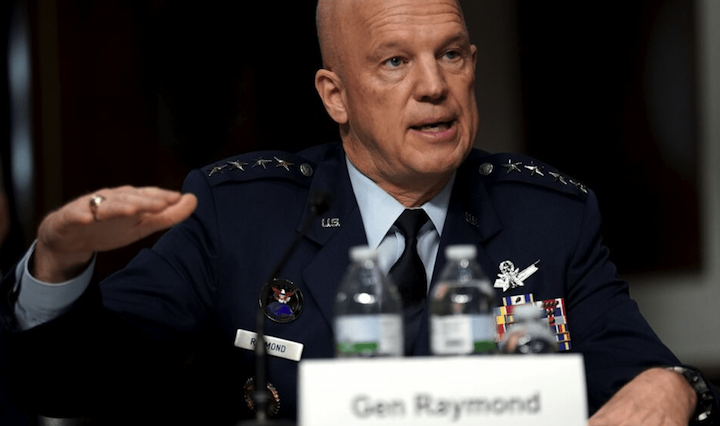“There are so many problems to solve on this planet first before we begin to trash other worlds.” – E A Bucchianeri
It is apparent that conflict of the military kind exists all over the Earth.
Despite man’s best efforts to create peace, wars continue, and so does the burgeoning arms industry.
Five US companies – Lockheed Martin, Boeing, Northrop Grumman, Raytheon and General Dynamics – accounted for US$148 billion and 35% of total Top 100 arms sales in 2018.
But now, there is talk of yet another Cold War space race. And by the way, all those five companies named above would benefit, should that occur.
Motivated by the space investment of Russia and China, US President Donald Trump signed a defense spending bill in December 2019 to create the Space Force officially. It’s the sixth branch of the US Armed Services, and the first new military service since the US Air Force was created in 1947.
Of the $72 million in funds originally requested for the Space Force in fiscal year 2020, the US Congress granted only $40 million in its bipartisan spending deal, Forbes reported.
“Space is the world’s newest war-fighting domain,” Trump said during the signing. “Amid grave threats to our national security, American superiority in space is absolutely vital. And we’re leading, but we’re not leading by enough. But very shortly we’ll be leading by a lot.”
According to NPR, the idea, and Trump’s provocative statements, were widely mocked, providing fodder for late-night talk-show hosts, cartoonists and comedy writers.
Senior military officials have previously raised concerns about what it will cost, and former defense secretary Jim Mattis warned against rushing into creating the force without clearly defined goals.
And what exactly are those “grave threats” Trump spoke of?
So-called counter-space capabilities developed by China include kinetic-kill missiles, ground-based lasers, orbiting space robots and space surveillance to monitor objects across the globe and in space, Space News reported.
Electronic weapons – such as satellite jammers, cyber capabilities and directed-energy weapons – also are part of China’s arsenal of counter-space systems.
Its space program is also expanding by leaps and bounds, with exploration of the moon and Mars well within its capabilities.
China’s government has made conquering space a key strategic priority, with the nation’s reported $8 billion space budget second only to the US, according to the Space Foundation, an American non-profit.
Meanwhile, the US says Russia has successfully tested a space weapon, Live Sciencereported.
The device, launched on July 15, is not a weapon but merely a satellite designed to inspect other satellites, so say the Russians.
But the US Space Command (USCC) said in a statement that the Russians launched an anti-satellite weapon – a very capable anti-satellite weapon.
Whatever it is, Russia launched it from another satellite, known as Cosmos 2543 – a satellite that was launched on November 25, 2019. It entered a new orbit, closely approaching (but not destroying) a third Russian satellite.
That behavior, USCC said, is “inconsistent with the system’s stated mission.”
For its part, aside from firing lasers at pesky UFOs, the US has said it does not want to get into a conflict that begins or extends into space.
But … like in all domains, the US military must be prepared for such a conflict, and that’ll take a lot of preparation, said its chief of space operations, General John W Raymond.
“We want to deter that from happening. However, if deterrence fails, a war that begins or extends into space will be fought over great distances at tremendous speeds,” Raymond said in a Department of Defense report.
To plan for warfare at the speeds and distances required to operate in space, the Space Force must be lean, agile and fast, Raymond said. The new military service has been working on all of those things since it stood up in December.
He also drew attention to verbiage on a display at the World War II memorial in Washington, DC. On the floors of both the north and south pavilions are etched the words “Victory on Land, Victory at Sea, Victory in the Air.”
Now, he said, those three domains are no longer enough to ensure victory. Today’s security environment, he said, requires even more of American war fighters.
“I am not confident that we can achieve victory or even compete in a modern conflict, without space power,” he said. “I am not willing to lose in order to learn. Today the Space Force in answering that call to compete, forging a war-fighting service that is always above.”
What exactly will the Space Force do?
According to NPR, the new service branch in essence repackages and elevates existing military missions in space from the US Air Force, Army and Navy, said Todd Harrison, who directs the Aerospace Security Project at the Center for Strategic and International Studies.
“It’s about, you know, all the different types of missions our military already does in space – just making sure that we’re doing them more effectively, more efficiently,” said Harrison.
Most recently it drew media attention when it pondered the possibility of sending 3D printers into space, to build parts in orbit and repair satellites (dubbed Archinaut One, the National Aeronautics and Space Administration has awarded a $73 million contract to Redwire for its launch in 2022).
It also plans to develop “space trucks” that can haul satellites from one orbit to another, possibly as part of a defensive strategy to make them harder for adversaries to target.

What won’t the Space Force do?
“It’s not about putting military service members in space, it has nothing to do with NASA, it’s not about protecting Earth from asteroids or aliens,” said Harrison.
Let’s face it, we need a cloak-and-dagger military struggle in space – to borrow an expression from my Mom – just like we need a hole in the head. But we have to do it, because they are doing it.
That is the sole “Dr Strangelovian” argument for a bad idea. America will not tolerate a “space gap.”
There was a time when man looked up to the stars, and admired them for what they were – a stunningly beautiful overhanging canopy. It made men dream of going to those stars.
But somehow, we have lost our way. And, unfortunately, there is much money to be made amid this folly.
Professor Melissa de Zwart, the dean of law at the University of Adelaide, says growing commercial interest in the mining of precious minerals on asteroids and planets has heightened the danger.
“I think you have to be a realist about that,” she told ABC.net.
“Where you have resources, where you have competition for those resources, where you have investment of money in the extraction of those resources … there will be an expectation of security around that investment.”
The Japan Aerospace Exploration Agency (JAXA) has already successfully landed a robotic craft on an asteroid and taken samples.
Imagine the possibilities of mining gold, diamonds or rare-earth minerals on other planets, or even asteroids.
To his credit, the late US president Richard Nixon recognized the correlation between space exploration and foreign policy and grasped the initiative – something the current president seems incapable of.
In May 1972, during the first Moscow Summit of the SALT I talks, Nixon and Soviet premier Alexei Kosygin signed an Agreement Concerning Cooperation in the Exploration and Use of Outer Space for Peaceful Purposes, which committed both the USSR and the United States to the launch of the Apollo–Soyuz Test Project in 1975.
This signaled a significant shift from the combatant nature of the Cold War space race.

But it was actually president Jimmy Carter – who wanted to restrict the use of space weapons – who broke ground in the area of military space policy, Space.com reported.
Carter signed a 1978 directive that stressed the importance of space systems to national survival, as well as the administration’s willingness to develop an anti-satellite capability.
The 1978 document helped establish a key plank of US space policy: the right of self-defense in space. And it helped the US military view space as an arena in which wars could be fought, not just a place to put hardware that could coordinate actions on the ground.
And then there was the late president Ronald Reagan’s ambitious Strategic Defense Initiative (SDI), which would have used a network of missiles and lasers in space and on the ground to protect the United States against nuclear ballistic missile attacks.
Known as “Star Wars,” the initiative cost taxpayers $30 billion, but no system was ever deployed.
Will the US, Russia and China sit down and draw up a peace plan for space? Highly unlikely, given the situation.
Xi Jinping’s aggressive “wolf warrior” policies preclude any suggestion of a concession, and Vladimir Putin … well, he’s too busy eliminating his rivals with Novichok.
For one thing, rapidly expanding technology and the era of the super-weapon have in essence pushed the US into a corner.
As US Secretary of Defense Mark Esper noted in January, nations have been in space for many, many years. “It’s just been recently that both China and Russia pushed us to the point where it now became a warfighting domain.”
As a result, Esper – a straight shooter by all respects – said the US has established the Space Command and just recently, Space Force, “to make sure that we can preserve space as a global commons.”
“It’s important not just to our security, but to our commerce, our way of life, our understanding of the planet, weather, you name it. So it’s very important that we – we now treat it that way and make sure that we’re prepared to defend ourselves and preserve space.”
For another, former president Barack Obama – who ironically was given the Nobel Peace Prize – put the US on track for this, when he signed legislation that unsettled the decades-old balance of power among the major nuclear states.
The National Defense Authorization Act, a policy bill encompassing virtually every aspect of the US military, contained two provisions with potentially momentous consequences.
One struck the word “limited” from language describing the mission of the United States’ homeland missile defense system.
The other related to a provision calling for the Pentagon to start “research, development, test and evaluation” of space-based systems for missile defense.
No wonder Putin is pissed off.
We can bash Trump all we want over his Space Force initiative, but let’s be honest, this was bound to happen. As man extends his reach into space, so too goes his hubris.
“It is absolutely inevitable that we will see conflict move into space,” Michael Schmitt, professor of public international law and a space war expert at the University of Exeter, told The Guardian.
“I am convinced beyond a scintilla of doubt.… It’s going to happen,” says Schmitt.
One only hopes that cooler heads prevail, à la Richard Nixon.
Quelle: Asia Times

